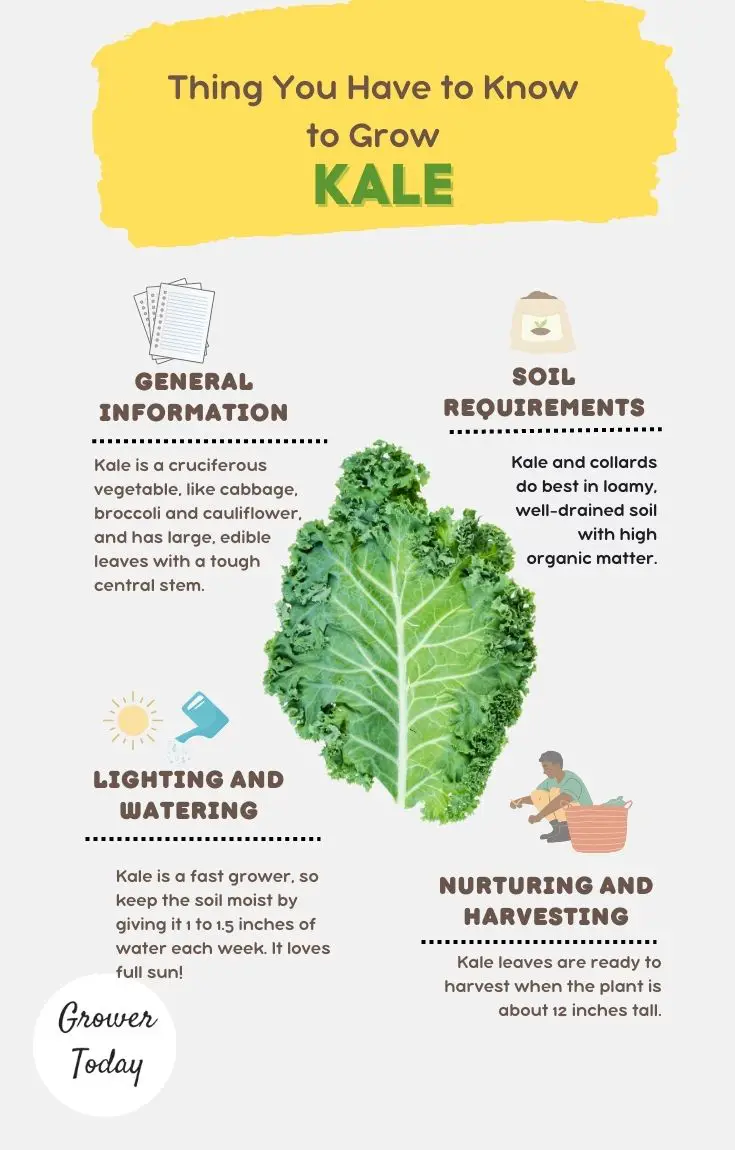Last Updated on April 20, 2023
Kale is one of the easiest and best leafy greens to grow currently. Also dubbed a superfood due to its many health benefits, if you’re a health enthusiast, you definitely want to know how to harvest kale so the leaves keep growing and give you a continuous harvest.
To learn how to do this right, let’s keep reading.
Summary: How to Harvest Mature Kale
To harvest Kale, grasp the stem of the mature outer leaf at the base of the main stalk and pull down and out, away from the center, until it breaks. Ensure that you leave at least 5 central leaves on the plant so that it keeps growing.
What is Kale?
Brassica oleracea var. sabellica, commonly known as kale is a leafy green vegetable that belongs to the cabbage family and is grown for its edible leaves.
Mostly eaten raw in salads, but can also be eaten cooked, kale has a variety of micronutrients such as vitamins A, C, and K, minerals, antioxidants, carotenoids, glucosinolates, and polyphenols, all of which are beneficial to human health.
If you plant kale at the right time, you will have a long season of harvest which will give you ample time to enjoy your fresh greens. Kale is typically a cool-weather vegetable but you can get a longer harvest if you plant it late in the summer to harvest in the fall and winter. It is also surprisingly hardy and frost tolerant. Certain cold-tolerant varieties will keep growing as long as the weather stays above 20°F.
This plant produces so many large leaves that when it is mature, it takes you only a few minutes to gather enough for a nutritious meal.
Most varieties of kale are biennial, meaning they have a two-year life cycle but people mostly grow it as an annual with a one-year growth cycle. Some kale varieties are perennial and can live for 5-7 years.
When to Harvest Kale
Kale is as easy to harvest as it is to grow. However, you need to know exactly the method and the right time to harvest it. So when is the best time to harvest kale? Well, this will depend on the variety or cultivar of kale that you are growing as they have different rates of growth.
There are also two distinct harvesting stages of kale, baby kale, and mature kale. The timing of the harvest will depend on what stage you want to harvest the leaves at.
Kale typically matures approximately 60 days after the seeds have been planted in the soil. By the time healthy plants reach this point, they will have at least 10 leaves with the larger ones on the outside and the smaller ones on the inside.
If you want to harvest your kale leaves while they are in the baby stage, this is best done 25 to 30 days after planting the seeds.
Kale is usually harvested in the late spring months, early summer, and again in autumn.
The time of harvest can also depend on the growing zone you are in and the time of the year. If you have a climate that greatly favors kale growth, you can harvest kale every one or two weeks.
Some kale gardeners even like to plant kale in the fall so that it can go through a frost before harvesting. The cold weather causes the plants to convert their starches to sugar, which greatly improves their taste.
How to Cut Kale From Garden
Harvesting kale is an extremely simple process. You can easily cut off the individual leaves without damaging the entire plant. This is as long as you don’t cut the central bud.
Here are the considerations to keep in mind when harvesting kale from the garden;
- Cut off the leaves where the leaf stem meets the main stem of the plant – instead of cutting, you can also break the leaves from the stem by pushing it down with your thumb and pulling it away from the plant.
- Do not cut the main stem of the plant – if you cut the team off, the plant will stop producing
- Leave about 1/3 of the leaves on the plant so that it can regenerate over time – pick as many leaves as you want from the kale plant, but do not leave it bare if you wish to continue harvesting
- Do not cut the root of the plant – this should go without saying, but if you cut the roots of your kale plant it will die
- Pick the largest and oldest leaves first – this will give the younger plants time to grow before they can be harvested
- Use the same method whether you are harvesting kale in the baby or the mature method – this way, your kale will keep growing
- While harvesting, watch out for and remove yellow or spotted leaves – remove any yellow or spotted leaves as soon as you notice them. Leaving sick or dead leaves on the plants will take up energy that the plant should be channeling toward healthy growth to extend your harvest. If you consistently spot any yellow, spotted, or wilted leaves on your plants, it could be a sign of distress. Check for any possible causes such as common kale pests like cabbage worms and aphids, overwatering, or a nutrient deficiency. Once you have established what the cause is remedy it as soon as possible to give your plant the best chance of survival. If it is a watering issue, adjust your watering schedule, if the cause is pests, include pest control in your maintenance routine, I recommend you read the article Amazing Natural Insect Pest Control Methods that Works.

How to Harvest Baby Kale
If you’re growing baby kale for use in salads, the best time to harvest them is 25-30 days after planting. The best variety for baby kale is the Red Russian and it is commonly grown for this purpose
Wait until the plants have multiple leaves that are about 2-3″ in length. Just keep in mind that when you harvest the leaves smaller, the yield per plant will also be smaller.
To harvest small kale leaves, simply use your fingers to pinch each individual leaf at the base of the stem. You can also use a sharp pair of scissors or a knife to cut the leaves. Grab a handful of leaves and cut them off about two inches above the ground. This will enable your plant to keep growing as long as you keep the central point intact.
To keep harvesting young kale leaves, watch them carefully for about 3-4 weeks because kale can quickly outgrow the baby stage.
How to Harvest Mature Kale
Full-size, grown, or mature kale leaves have a tougher texture and a stronger flavor than baby leaves. Older leaves can become discolored and eventually fall off the plant. If you notice this happening, remove these leaves and only harvest the ones that still look green and healthy. When you pick mature kale leaves, ensure that you leave at least 5 central leaves on the plant so that it can continue to make food via photosynthesis and keep growing.
For mature kale leaves, it is best to cook before consuming them or use them to make kale chips. You can also massage them thoroughly before eating them if you don’t want to cook them
When they’re mature, they should be about the size of an adult’s palm or bigger. To harvest them, grasp the stem of the mature outer leaf at the base of the main stalk and pull down and out, away from the center, until it breaks. Repeat the same process until you have harvested all the leaves that you want. If your plants are still new or you are worried about damaging them, you can also use a knife, scissors, or running shears instead of your hands to harvest. This will help to prevent snapping the stem.
Kale Growth Period
Kale days to harvest is about 55-60 days after planting, as that is the regular period it takes to mature. If the kale is planted from seed in the soil, however, it can take closer t 3 months before they are full-sized.
How to Store Kale after Harvest
Freshly picked kale leaves can be stored and last up to 2-3 weeks in the refrigerator if stored well. Do not store it without protection in the fridge because it will quickly wilt. Put the leaves in a ziplock plastic bag or a storage container.
Kale can also be frozen, and last about 4-6 weeks before turning bitter. To do this properly, wash and chop the leaves before freezing them.
If you want to keep kale in the freezer for more than 6 weeks, you can blanch it before freezing. This way it will store for about 8-12 months.
Whichever way you decide to store your kale, follow these basic preparation steps:
Step 1: Wash
Wash all the harvested kale leaves thoroughly with cold water, because hot or warm water will make them wilt, and you want to maintain the crunch.
Step 2: Cut
Remove or cut off the stems, unless you want to eat them.
Step 3: Dry
Pat the leaves dry with a towel or let them air dry for about 10 minutes.
Step 4: Put them in a bag
Put the clean and dry leaves in a resealable storage bag or container, with a piece of paper towel to absorb moisture and prevent it from damaging the leaves.
Step 5: Squeeze out the air
If you’re storing them in a bag, squeeze out as much of the air as you can.
Step 6: Store
Store the leaves in your preferred place. If the leaves go yellow before you eat them, throw them away.
You can grow many other green leafy vegetables like Spinach or Lettuce
Conclusion – How to Harvest Kale So the Leaves Keep Growing
Kale is a nutritious vegetable and can be used to prepare delicious dishes with a bit of information. Knowing when and how to harvest kale is also important, depending on what you plan to use them for. This article provided you with all the information you could ever need on how to harvest kale so the leaves keep going, kale days to maturity, and how to store your harvested kale. We hope that you found it very helpful and will now go and grow your kale and harvest it properly for long periods of time.
Happy growing!

An aquaculture specialist and freelance writer. Passionate about anything sustainable living, such as growing your own food, and if you can do it in conjunction with fish farming, even better! I currently work as an aquaculture researcher where I can expand and share my knowledge and skills on aquaculture, crop farming and adding value to wastewater by using it to grow food products. I enjoy reading and learning as much as possible, and writing is another avenue for me to share the knowledge I gain with others. I want my writing to inspire people to try their hand at gardening, whether indoors or outdoors. You can even start by keeping a few houseplants indoors to help you gain a bit of confidence if you need to.
